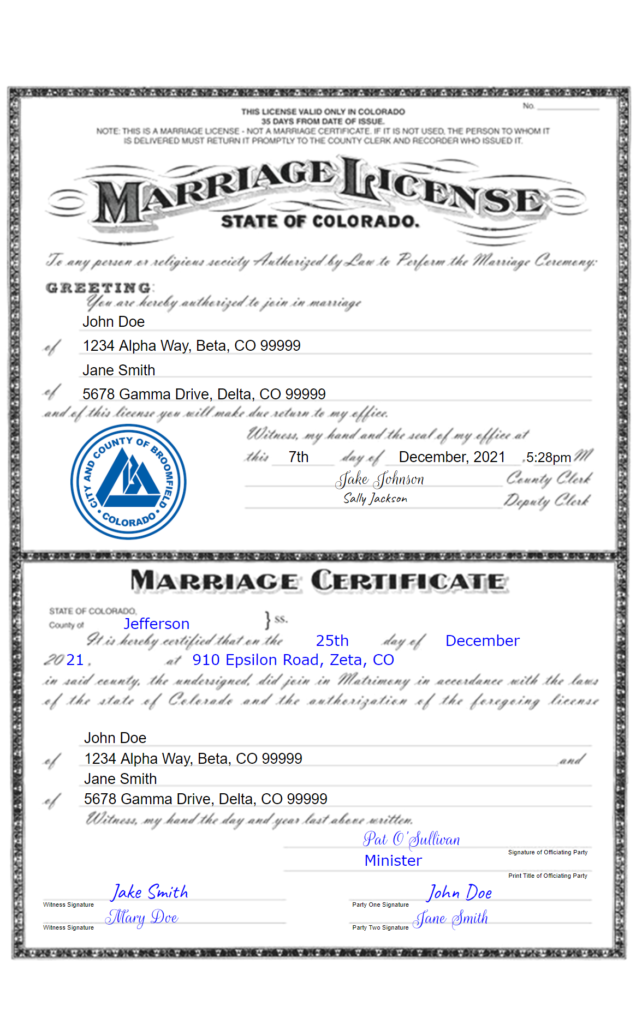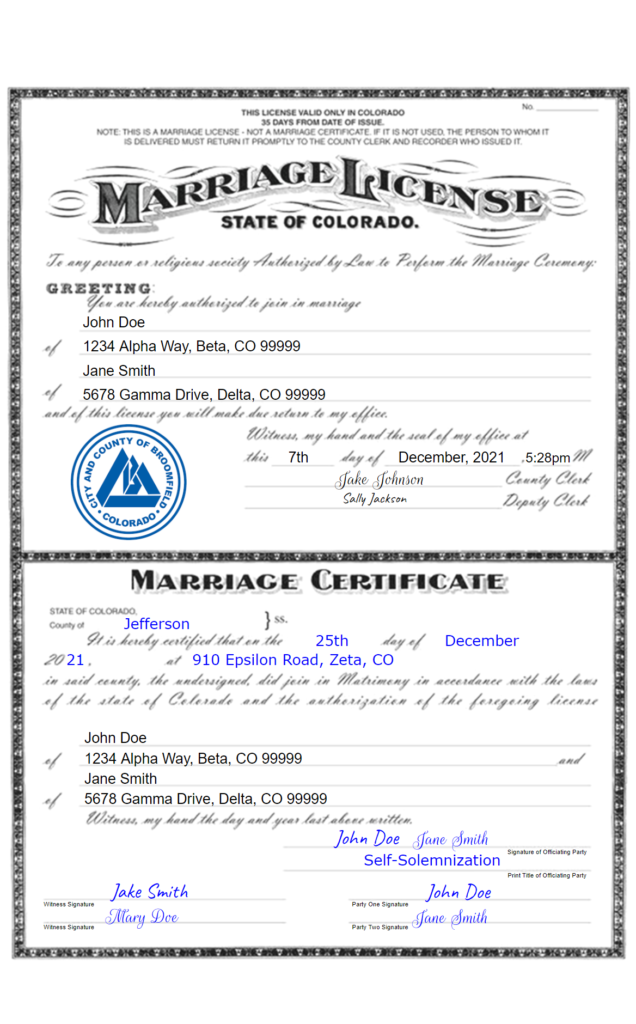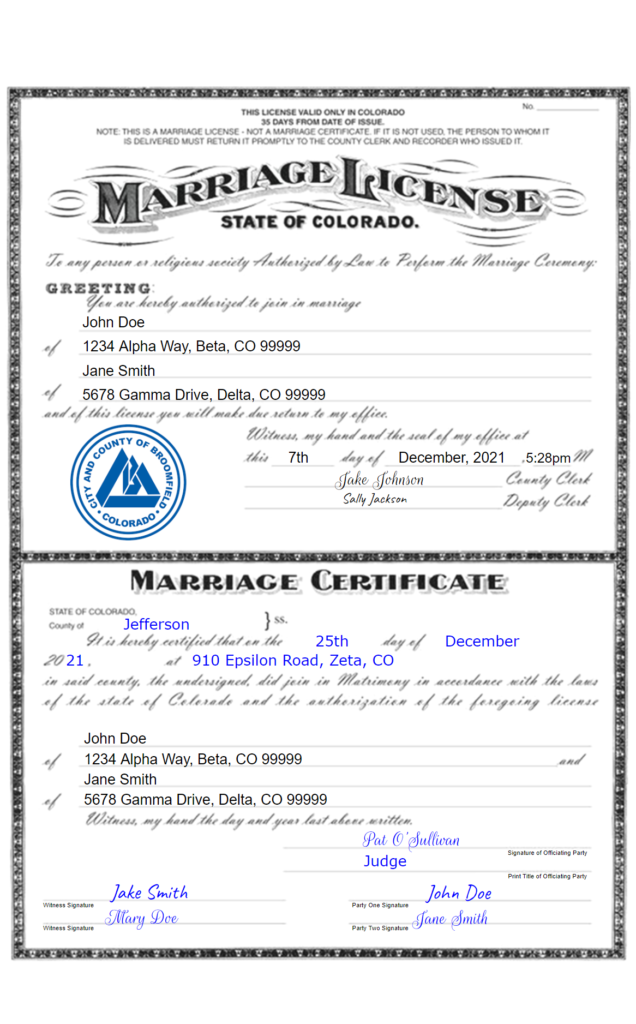How to Fill Out A Colorado Marriage License
Introduction
We are not lawyers and this is not legal advice. The information contained here is the summation of many county’s instructions on how to fill out a Marriage License plus the experience we’ve gained filling them out. Collectively, we’ve filled out or assisted filling out well over 1,000 Colorado Marriage Licenses. So this isn’t our first rodeo. That said, the instructions on how to fill out a license are the not the same from county to county. And while this guide will help you through the process and help you ask the right questions, please talk with the Colorado County Clerk providing your Marriage License and confirm precisely what they want you to do. They are the ones who will determine if you’ve filled it out to their satisfaction, so it’s best to do what they ask.
Two Documents in One
Now, before we dig in to the details, it is important to realize that even though they are printed on the same piece of paper, the Marriage License and the Marriage Certificate are technically separate documents. The purpose of the Marriage License is to pre-approve the legal binding and let whoever is performing the Marriage Ceremony know that the legal ground work has been completed. The purpose of the Marriage Certificate is to record in writing and certify that a legal Marriage Ceremony has been performed. Do not physically separate these documents. As the words ‘Marriage License’ are in large fancy bold font across the top, it is customary to refer to the paper and both license and the certificate collectively as ‘the Marriage License’.
When to Fill it Out
We strongly recommend that you do not fill out and sign your Marriage License until after the ceremony has been completed. If you fill it out and sign before the ceremony, it may invalidate your license or perhaps make it challengeable in court if this ordering is discovered and brought to light.
Making it Legal
Once you’ve filled out the Marriage License, you must return it to the County Clerk and Recorder that you obtained it from. You can either hand deliver it back to them or you can mail it to their mailing address. Once they have it, they will check to make sure it has been filled out properly, record it and then get it back to you. If you’ve hand delivered it, they may record it while you wait and hand it back to you right away. Otherwise, if you mailed it in, they will mail it back to you at the address you gave them when you applied for the license. The Marriage is only legal once the Marriage License has been recorded.
What the Clerk Fills Out For You
When you go to get your Colorado Marriage License, the clerk will use the information you provide to fill out the Marriage License and make sure everything is in order. On the Marriage License the clerk will fill out the following fields:
[PARTY ONE NAME] – This is your name or your partner’s name.
[PARTY ONE ADDRESS] – This is your address or your partner’s address.
[PARTY TWO NAME] – This is your name or your partner’s name.
[PARTY TWO ADDRESS] – This is your address or your partner’s address.
[DAY] [MONTH] [YEAR] [TIME (optional)] – This when the license was issued.
[COUNTY SEAL] – This space is reserved for the county seal. The county clerk may stamp, print or emboss the county seal onto the Marriage License. Most of the time they use this space, but sometimes they put the seal somewhere else.
[COUNTY CLERK SIGNATURE] – This is the signature of the elected county clerk. It is sometimes signed, printed or stamped.
[DEPUTY CLERK SIGNATURE] – This is the signature of the deputized county clerk issuing the license. It is sometimes signed, printed or stamped.
Sometimes, at the very bottom of the Marriage License, the Clerk will include the address they will use to mail your marriage license back to you.
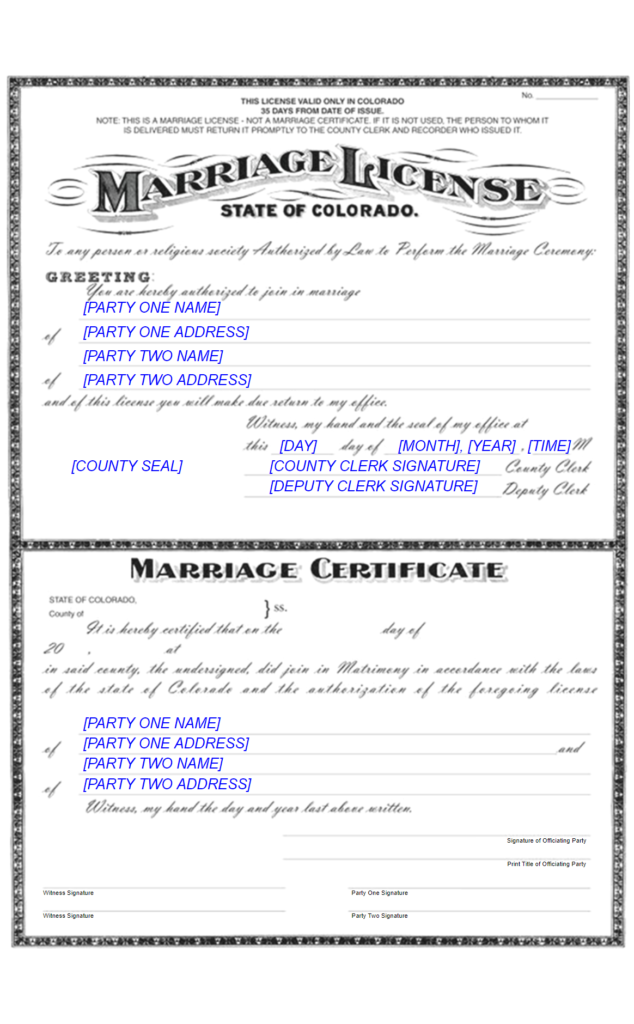
Example Marriage License as You Receive It
This is roughly what the license will look like when they hand it to you.
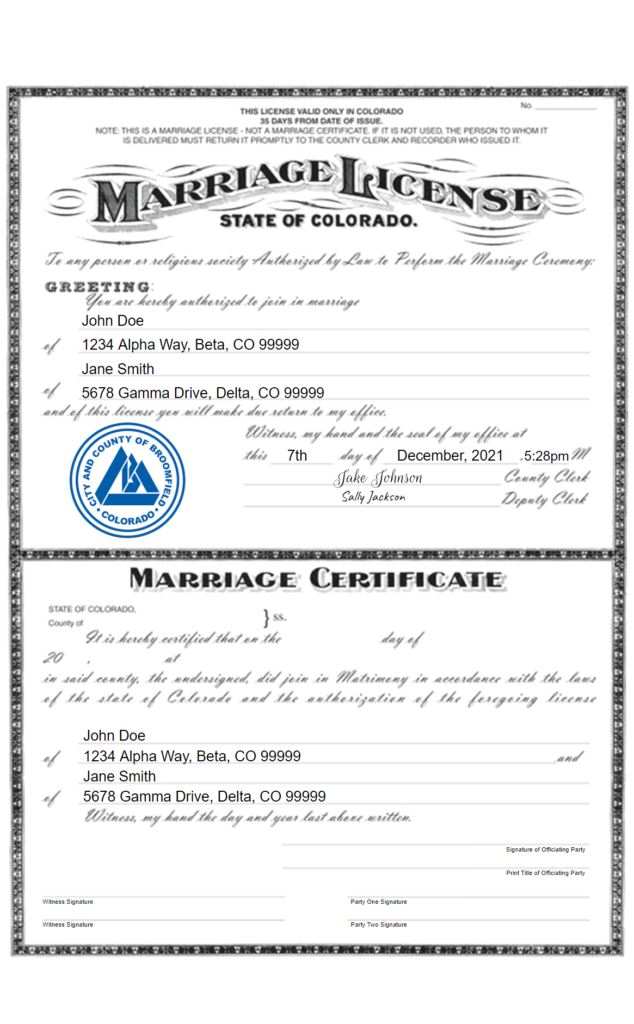
How to Fill Out the Marriage License
When you are filling out a legal document of any type, we highly recommend that you use a ball point pen. Ball point pens use oil-based ink which is more fade resistant than the water-based inks you find in gel pens. And you probably want your ink to outlast your marriage! As with any legal document you should sign in blue or black ink. And if you’d like to know more about why, The Law Depot has a great article explaining the details… Ink for Legal Documents
Sound Mind and Body
It is common on the big day for couples to engage in the use of alcohol. Please enjoy responsibly. But be aware that entering into a legal agreement (e.g. getting married) while intoxicated, may invalidate your legal marriage or you may find that your wedding officiant is unwilling to perform the ceremony based on your state of being. Be patient… you can let loose after the ceremony.
What You Need to Fill Out
Here is where we get into what you need to do. Some of the things you’ll fill out are common amongst all Colorado Marriage Licenses, and others vary more from county to county.
- [COUNTY OF CEREMONY] – This is the county in which the ceremony was performed. You can use this tool to determine your county by either typing in the address of the ceremony or move & zoom to select the spot on the map where your ceremony took place. This tool will tell you what County that spot is in.
https://www.randymajors.org/countygmap
- [DAY] – This is the day of month when the ceremony took place. Most County Clerk & Recorders seem to prefer a number format (e.g. 1st, 14th, 22nd) and dislike a word format (e.g first, fourteenth, twenty second).
- [MONTH] – This i the month in which the ceremony took place. Most County Clerk & Recorders seem to prefer a full word for the month (e.g. January, April, September).
- [Y] – Here you’ll need to fill out the last two digits of the year. As a helpful hint, they have include the ’20’ – the first two digits of the year. All you will need to put here is the last two digits, something like 22, 23 or 24 – whatever year your ceremony has taken place.
- [???] – This seems to be the tricky one. Some counties will tell you to leave this space blank. Some counties will instruct you to put the time the ceremony took place (e.g. 4pm or 6:30pm). And some counties will look for you to put in the calendar notation for the year (e.g. AD {Anno Domini} , CE {Common Era}, etc.). Find out what they prefer and do that.
- [ADDRESS OF CEREMONY] – The best advice I’ve received from a clerk was that what you put on this line needs be able to be found by someone 100 years in the future.
- Postal addresses: These are golden as they are standardized and easy to track backwards in time through post office records (e.g. [Street Address] [City] [State] [Zipcode]). If you have a choice we highly recommend using this wherever possible.
- Park or Forest Locations: If you’re at a large park, forest or open space, you will need to know the name of the park, forest or open space and the closest city. Your basic format here is…”[Location in Park (if known)] [Park/Forest/Open Space Name] [City Name] [State]”. Google Maps can be really helpful here in figuring out the city. If you put a pin where you are doing your ceremony it will often tell you what city is closest or has jurisdiction there. So in the end you’ll have something like “Sprague Lake, Rocky Mountain National Park, Estes Park, CO” or if you’re not at a particular site in the park, then just “Rocky Mountain National Park, Estes Park, CO” will do.
- NOTE: We do not recommend you use location names that unlikely to stand the test of time. For instance, if you’re doing your ceremony at the ‘Eagle’s Crest’ BnB or the ‘Black Mountain Ranch’ these are either business names or names made up by the owners that are unlikely going to stand up to the test of time.
- [OFFICIANT SIGNATURE] [OFFICIANT TITLE] – There are three ways to perform a legal ceremony (otherwise known as solemnize a marriage): civil, religious or self. And based on which one you choose, these two lines will be filled out differently.
- Civil: A civil ceremony is performed by a judge, a court magistrate or other public official authorized to perform a ceremony. If you choose this type of ceremony you’ll have to find one of these people to perform the ceremony for you. And once it’s done you need to have them sign the license and preint their title (e.g. Judge, Magistrate, etc).
- Religious: A religious ceremony is performed by a religious or tribal official authorized to perform a ceremony. There are legally recognized religions for just about anything. From the typical Christian, Islamic, Jewish, etc. to the more modern Atheist, Humanist, Agnostic, etc. all the way to the fanciful Jedi, Dudeist, Cannabis, etc. Wedding officiants are not required to be registered with the State of Colorado, but must be ordained through a legally recognized religion. If you are choosing a less traditional religion to get married in, we recommend you look into their actual credentials just to be safe. And it’s here where you can have a friend or relative marry the two of you. They need to get ordained, which can be as easy as 30 seconds online (we recommend ULC.org). In this case, you’ll need them to sign and print their religious title (e.g. Minister, Reverend, etc). ‘Officiant’ is not a title and will get rejected by the Clerk.
- Self: Self-Solemnization is a process widely available in Colorado and Pennsylvania, and with some restrictions in Illinois, Wisconsin, District of Columbia, California, Maine, Nevada and Kansas. Basically it allows you to marry yourselves without an officiant present. In this case, you both will sign on the ‘Signature of Officiating Party’ line. On the ‘Print Title of Officiating Party’ line, you’ll need to check with the County Clerk. Some want you to write ‘Self-Solemnize’ on that line, while others want you to simply print your name. If you choose to do this, we would recommend double checking with the Clerk that this is how they want you to fill it out. And when possible, fill it out either when obtaining the license or handing it in so the Clerk can guide you through the process
- [PARTY ONE SIGNATURE] – Whoever is named as Party One, signs here. Counties provide varying instructions on how to sign your name. If you are not changing your name, sign normally. If you are planning on changing your name, some counties will encourage you to use your new name while others insist on your current legal name. We encourage you to do as they recommend. If you are curious and want to know more about signatures, The Law Depot seems to have some good information covering that here… Your Guide to Signing Legal Contracts
- [PARTY TWO SIGNATURE] – Whoever is named as Party Two, signs here. See above.
- [WITNESS SIGNATURE (optional)] – There are two lines available for witnesses to sign. These signatures are optional and not required. Some religions specify that two people should serve as witnesses and these line allow them to record who the witnesses were. They have no legal weight. However, they can also be something honorific for two people who you’d like to give the honor of signing your Marriage License.
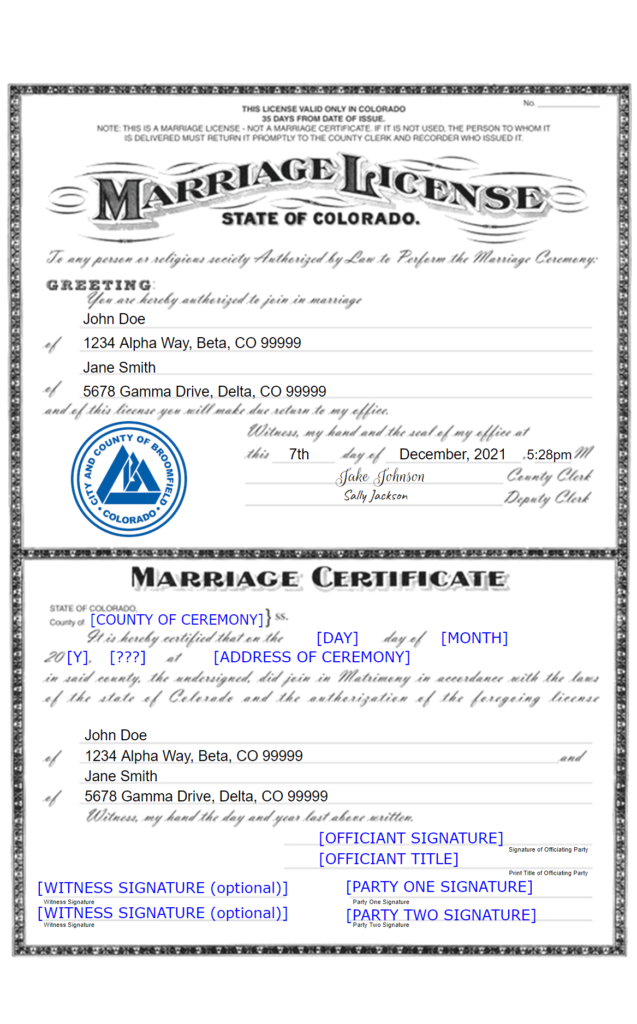
Example Marriage Licenses
Once you’re done filling it out, it should look similar to one of the following examples…

